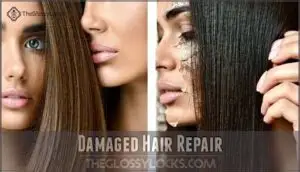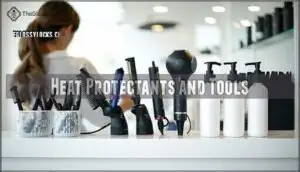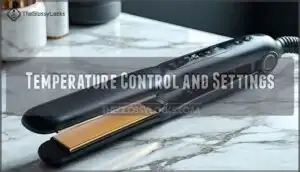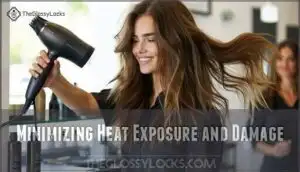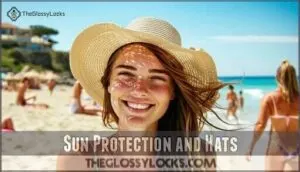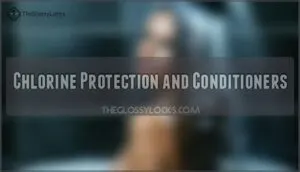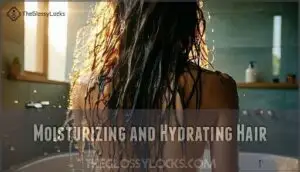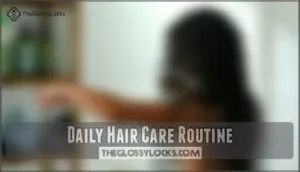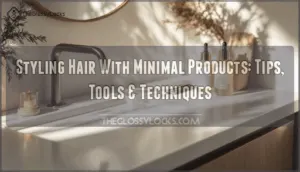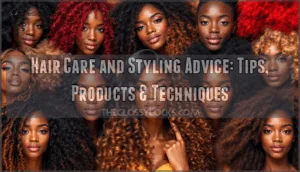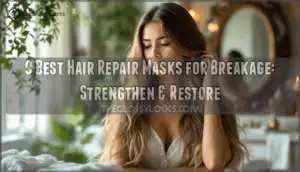This site is supported by our readers. We may earn a commission, at no cost to you, if you purchase through links.
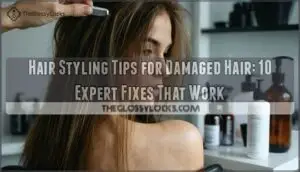 Your damaged hair isn’t beyond saving – you just need to treat it like the delicate silk it’s trying to become again.
Your damaged hair isn’t beyond saving – you just need to treat it like the delicate silk it’s trying to become again.
Start with heat protectant before any styling, and keep temperatures below 300°F. Think of your hair as fragile fabric that needs gentle handling.
Use wide-tooth combs on wet hair, and never brush when it’s soaking wet. Deep conditioning treatments twice weekly work like medicine for brittle strands.
Air-dry when possible, or use the cool setting on your blow dryer. These hair styling tips for damaged hair focus on protection first, styling second.
The real game-changers involve specific products and techniques that most people overlook, including the use of cool setting on your blow dryer.
Table Of Contents
- Key Takeaways
- Preventing Hair Damage
- Damaged Hair Repair
- Top 10 Damaged Hair Styling
- 1. Garnier Oat Delicacy Hair Milk
- 2. Its a 10 Keratin Conditioner
- 3. Head Shoulders Coconut Oil Hair Masque
- 4. Clairol Nice n Easy Light Golden Brown
- 5. TRESemmé Heat Tamer Heat Protectant
- 6. Loreal Elvive Total Repair Leave In
- 7. K18 Leave In Hair Mask
- 8. Vernon François Nourishing Hair Mist
- 9. RŌZ Santa Lucia Hair Styling Oil
- 10. Living Proof No Frizz Oil
- Heat Styling Tips
- Environmental Protection
- Daily Hair Care Routine
- Frequently Asked Questions (FAQs)
- Which hairstyle is best for damaged hair?
- Can damaged hair be styled?
- What is the best hair care routine for damaged hair?
- How can I make my damaged hair look less damaged?
- Can I color damaged hair safely?
- Which hairstyles work best for damaged hair?
- How often should I wash damaged hair?
- What ingredients should I avoid in products?
- When should I see a professional stylist?
- Conclusion
Key Takeaways
- Use heat protectant every time – Apply heat protectant before any styling and keep temperatures below 300°F to prevent further damage to your already fragile strands.
- Switch to gentle handling techniques – Use wide-tooth combs on wet hair, never brush when soaking wet, and choose loose protective styles over tight ones that stress weakened hair.
- Deep condition twice weekly – Regular deep conditioning treatments work like medicine for brittle hair, restoring moisture and strengthening damaged bonds from chemical processing or heat damage.
- Trim every 6-8 weeks religiously – Regular trims prevent split ends from traveling up the hair shaft, stopping breakage before it spreads and keeping your damaged hair looking healthier.
Preventing Hair Damage
You can stop hair damage before it starts by understanding what hurts your hair most.
The three main enemies are rough brushing, harsh chemicals, and excessive heat, but simple changes to your daily routine can protect your strands from breaking.
This approach allows for simple changes to make a significant difference in hair health.
Mechanical Damage Causes
The wrong brushing techniques can turn your hair into a brittle mess.
Wet hair stretches like taffy, making it vulnerable to breakage when you brush aggressively.
Your hair becomes as fragile as spun glass when wet—handle with the care you’d give delicate silk.
Tight hair ties create tension spots that snap strands, while environmental factors like wind and friction add daily wear.
Switch to protective styles and gentle detangling to save your damaged hair from further styling disasters.
Chemical Damage Prevention
Chemical treatments can wreak havoc on your strands, but you’re not powerless.
Always perform patch tests before using hair dyes or bleach. Choose gentle formulas and limit processing frequency.
Professional application reduces risks substantially. Space treatments at least six weeks apart, and invest in strengthening treatments between sessions.
Your chemically damaged hair will thank you for this thoughtful approach to prevention.
Heat Damage Prevention
Heat protectants are your hair’s best friend before styling.
Apply them to damp strands, then adjust tool temperature below 350°F.
Air drying beats blow-drying when possible.
Limit styling tools to twice weekly max – your hair needs recovery time.
These simple heat damage prevention steps keep heat damaged hair from getting worse while maintaining your favorite looks.
Damaged Hair Repair
Once your hair’s damaged, you can’t completely reverse the breakage, but you can repair what’s left and prevent further harm.
Regular deep conditioning treatments, peptide masks, and strategic trims every six to eight weeks will restore moisture, strengthen weakened strands.
This will keep your hair looking healthier than you thought possible, by restoring moisture and overall hair health.
Conditioning and Moisturizing
Your damaged hair repair journey starts with the right conditioner types.
Rinse-out conditioners after shampooing replenish your hair’s protective layer, while leave in conditioner on damp strands prevents further breakage.
Weekly deep conditioning treatment with moisturizing hair mask ingredients like keratin restores bonds.
Hydrating hair products with ingredient benefits from proteins seal damage effectively.
Using the right hair products is essential for repair.
Regular Trims and Peptide Treatments
Scissors become your hair’s best friend when you trim every six to eight weeks.
This trim frequency prevents split ends from traveling up the hair shaft, stopping breakage before it starts.
Peptide treatments like K18 rebuild damaged protein bonds, delivering impressive hair strength and treatment longevity.
A power peptide treatment can deeply repair hair by penetrating the cuticle.
These protein treatment hair solutions work alongside regular cuts for complete split ends remedy and effective hair breakage prevention.
Top 10 Damaged Hair Styling
You don’t have to let damaged hair ruin your styling routine when you’ve got the right products in your corner.
These ten expert-approved styling solutions will help you manage frizz, add moisture, and protect your strands while creating the looks you want.
They will help you achieve the style you desire with the right products.
1. Garnier Oat Delicacy Hair Milk
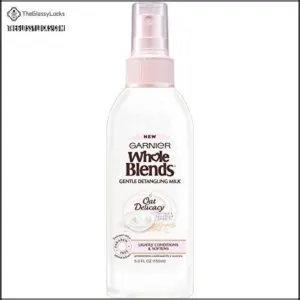
Starting with an affordable powerhouse, Garnier Oat Delicacy Hair Milk transforms your damaged strands without breaking the bank.
This lightweight detangling spray contains oat milk and rice cream extracts that moisturize and soften hair while you’re styling.
You’ll love how it tames frizz and makes brushing effortless, especially on chemically treated hair.
The paraben-free formula won’t weigh down fine hair, and its gentle ingredients work perfectly for sensitive scalps.
Simply shake, spray on damp hair, and watch your tangles disappear like magic.
Best For: People with fine, curly, or chemically damaged hair who need lightweight hydration and detangling without weighing hair down.
- Leaves hair soft, manageable, and frizz-free.
- Enriched with natural extracts and paraben-free.
- Affordable and works well for sensitive scalps.
- Requires multiple sprays for optimal results.
- Can leave a film or make hair feel crispy if overused.
- Scent intensity may be too strong for some users.
2. Its a 10 Keratin Conditioner
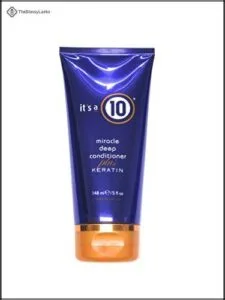
In the case of reversing keratin depletion, It’s a 10 Keratin Conditioner works like a charm for your damaged strands.
This deep conditioning treatment penetrates your hair shaft, restoring structure while sealing the cuticle for enhanced shine.
You’ll apply it after shampooing, comb it through, and leave it on for 5-20 minutes.
The keratin amino acids and hydrolyzed keratin restore lost moisture to dry, brittle hair.
It’s particularly effective for chemically treated hair, leaving your locks smooth, strengthened, and detangled.
Best For: Those with dry, brittle, or chemically treated hair in need of moisture restoration and damage repair.
- Deeply penetrates to restore hair structure and seal the cuticle for shine.
- Effective for detangling and smoothing damaged or chemically treated hair.
- Sulfate-free formula protects against environmental and heat damage.
- Might require longer application time (5-20 minutes) for optimal results.
- Some users may find the keratin version less effective than the original formula.
- Packaging concerns noted by a few users.
3. Head Shoulders Coconut Oil Hair Masque
Head & Shoulders Royal Oils Deep Moisture Masque transforms your dry, damaged strands into soft, manageable hair.
This coconut oil-infused treatment balances your scalp while delivering intense hydration to natural, relaxed, and textured hair types.
You’ll love how it detangles effortlessly and defines your curls without breaking the bank.
The sulfate-free formula works wonders for weekly deep conditioning sessions.
Just remember to rinse thoroughly – this rich masque requires extra shampooing to remove completely, but the results are worth it, providing intense hydration and making your hair soft and manageable.
Best For: Individuals with natural, relaxed, kinky, or coily hair seeking intense hydration and improved scalp health.
- Infused with coconut oil for deep hydration and scalp relief.
- Sulfate-free, paraben-free, and dye-free formula for gentle care.
- Enhances curl definition and facilitates easy detangling.
- Requires thorough rinsing, potentially needing multiple shampoos to fully remove.
- Small container size may not last long for thick or heavy hair.
- Not suitable as a standalone treatment for severe scalp conditions.
4. Clairol Nice n Easy Light Golden Brown
Permanent hair color can breathe new life into damaged strands, and this formula delivers.
You’ll get 100% gray coverage that lasts up to eight weeks, thanks to its oil-infused blend that smooths your hair while it absorbs color.
The multi-dimensional shades create natural-looking highlights that disguise damage beautifully.
What sets this apart is the included Revitashine treatment, which strengthens hair bonds and seals in your new color.
It’s gentle enough for fragile hair yet powerful enough to transform your look completely, making it a great option for those seeking a complete hair transformation.
Best For: Those looking for long-lasting gray coverage and a natural, multi-dimensional color with added hair smoothness.
- Provides 100% gray coverage for up to 8 weeks.
- Includes Revitashine treatment to strengthen and seal color.
- Creates natural-looking tones with highlights.
- Some shades may run darker than expected.
- Risk of missing components in packaging.
- Availability of certain shades may be limited in stores.
5. TRESemmé Heat Tamer Heat Protectant
Shield your hair from heat damage with TRESemmé Heat Tamer Heat Protectant, your styling safety net.
This lightweight spray protects strands up to 450°F while adding shine and softness without weighing hair down.
You’ll love how it reduces frizz and prevents breakage during blow-drying or straightening sessions.
The water-soluble silicone formula won’t leave greasy residue, making it perfect for damaged hair that needs gentle care.
Simply spray on damp hair before styling, and you’re ready to create beautiful looks without the worry, using a product that provides gentle care.
Best For: People who use heat-styling tools frequently and want to protect their hair from damage while maintaining softness and shine.
- Shields hair from heat damage up to 450°F.
- Lightweight, non-greasy formula enhances shine and softness.
- Helps reduce frizz and breakage for healthier styling outcomes.
- Some users dislike the scent, though it dissipates quickly.
- Reports of packaging issues like leaks during delivery.
- May not meet expectations for those looking for fragrance-free options.
6. Loreal Elvive Total Repair Leave In
Packed with almond oil and protein, this drugstore gem works double duty as both a leave-in conditioner and heat protectant up to 450 degrees.
You’ll love how it detangles wet hair without weighing it down or leaving greasy residue.
The lightweight formula repairs damage while preventing future breakage, making your hair softer and more manageable.
Apply it to damp strands before styling, and you’re golden, enjoying affordable protection that punches above its weight class for damaged hair.
Best For: People with damaged, dry, or frizzy hair looking for an affordable leave-in conditioner that protects against heat and reduces breakage.
- Repairs damaged hair and prevents split ends.
- Lightweight formula detangles and smooths hair without greasiness.
- Acts as a heat protectant up to 450 degrees.
- Scent may not be appealing to everyone.
- Can cause buildup with frequent use.
- Less effective for thick and coarse hair.
7. K18 Leave In Hair Mask
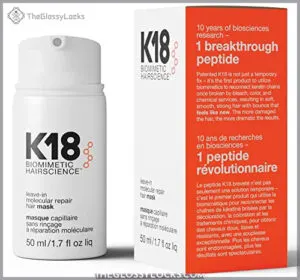
K18’s biotech-developed peptide technology repairs extreme damage by reconnecting broken polypeptide chains in just four minutes.
You’ll apply this leave-in treatment without conditioner, using three to six pumps depending on your hair length.
The patented formula works immediately and builds results over consecutive uses, transforming bleach-damaged, chemically-treated, or heat-styled hair into healthier strands.
Though pricey, this concentrated mask delivers lasting softness, reduced frizz, and improved manageability that integrates with your hair’s keratin structure for genuine repair.
Best For: People with bleach-damaged, chemically-treated, or heat-styled hair looking for fast and lasting repair.
- Expensive compared to alternatives.
- Results may vary, requiring multiple uses for noticeable improvement.
- Packaging authenticity concerns; verify before purchase.
- Repairs severe damage in just four minutes.
- Improves softness, manageability, and reduces frizz.
- Highly concentrated formula requires minimal product per use.
8. Vernon François Nourishing Hair Mist
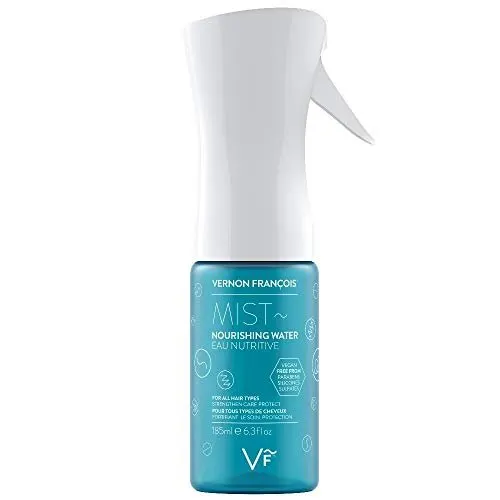
This lightweight mist delivers amino acids and natural botanicals straight to your strands, making it perfect for revitalizing curls or prepping hair before styling.
You’ll love how it detangles without weighing down your hair, while the protein-rich formula helps rebuild damage from the inside out.
Just a few spritzes on damp or dry hair works wonders.
The alcohol-free formula won’t dry out already compromised strands, and it doubles as a shine enhancer that protects against color fade.
Best For: Individuals seeking a lightweight, plant-based hair mist to detangle, revive curls, and protect hair from damage and color fade.
- Lightweight formula with amino acids repairs and strengthens hair without weighing it down.
- Multi-use product acts as a detangler, shine enhancer, and curl refresher.
- Alcohol-free and vegan-friendly, suitable for all hair types, including textured hair.
- High price point may deter some buyers despite the product’s longevity.
- Mixed feedback on scent, with some users reporting an unpleasant smell.
- Packaging issues, such as spills and faulty spray nozzles, noted by some users.
9. RŌZ Santa Lucia Hair Styling Oil
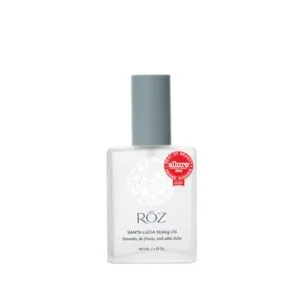 View On Amazon
View On Amazon
This multi-tasking hero tackles frizz while protecting your hair from heat up to 450°F.
You’ll love how this plant-based blend of argan, jojoba, and safflower oils smooths damaged strands without weighing them down.
Just a few drops go a long way—apply to damp hair before styling or use sparingly on dry hair for instant shine.
The lightweight formula won’t leave residue, and it smells amazing too.
Perfect for all hair types, this styling oil delivers salon-worthy results at home.
Best For: Individuals with all hair types looking for a lightweight styling oil to smooth frizz, add shine, and protect against heat damage.
- Lightweight, non-greasy formula that smooths damaged strands.
- Protects hair from heat up to 450°F, ideal for heat styling.
- Plant-based ingredients with a pleasant scent and nourishing benefits.
- Mixed effectiveness on taming frizz, especially for fine curly hair.
- Higher price point at $45.00 for 3 ounces.
- Requires proper use, as over-application may impact results.
10. Living Proof No Frizz Oil
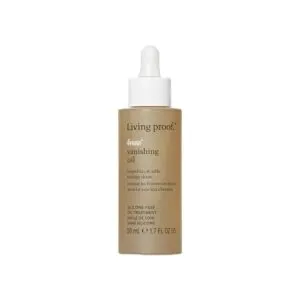 View On Amazon
View On Amazon
This silicone-free oil tackles frizz without weighing your hair down.
You’ll get lightweight moisture that absorbs quickly, making it perfect for daily use on damaged strands.
The formula blocks humidity while adding shine, so your hair stays smooth even on muggy days.
It’s designed for all hair textures and won’t leave greasy residue.
Apply 1-2 drops to damp or dry hair, focusing on mid-lengths and ends.
You can reapply throughout the day whenever frizz strikes, giving you consistent control over unruly hair, with the benefit of daily use.
Best For: Individuals with dry, frizzy, or damaged hair seeking lightweight, daily hydration and frizz control.
- Mixed reviews on effectiveness, especially for severe frizz
- Scent is subjective and may not appeal to everyone
- Quality concerns when purchased from third-party sellers
- Lightweight formula that absorbs quickly without leaving hair greasy
- Blocks humidity effectively, providing long-lasting frizz protection
- Suitable for all hair textures and daily use
Heat Styling Tips
You can still use heat styling tools on damaged hair, but you’ll need to be smart about it.
The key is using proper heat protectants, choosing the right temperature settings, and limiting how often you expose your hair to high heat.
Heat Protectants and Tools
Your heat protectant is your hair’s best friend against styling damage.
Choose sprays with silicone-based heat protectant ingredients that shield up to 450°F.
Ceramic plates distribute heat evenly, while titanium heats faster but requires careful handling.
Don’t forget blow-dryer attachments – they direct airflow and reduce cuticle damage.
For severely heat damaged hair, consider heatless styling methods between heat tool sessions.
Many heat protectants use copolymers or silicone to coat the hair.
Temperature Control and Settings
Your styling tools’ heat tool settings matter more than you think.
Keep temperatures below 300°F to stay within the safe damage threshold for fragile strands.
Most ideal temperature ranges fall between 250-285°F for damaged hair.
Check your tool calibration regularly since older devices lose temperature consistency.
Adjustable heat settings are essential for damage control.
This simple adjustment prevents unnecessary heat damage while achieving your desired hair styling results, ensuring you stay within a safe and effective temperature range.
Minimizing Heat Exposure and Damage
Protecting your hair from heat damage doesn’t mean giving up your favorite styles completely.
Smart strategies can help you maintain healthier locks while still achieving the looks you love.
Here are five ways to minimize heat exposure:
- Lower tool temperature to 300°F or below for fine hair
- Use heat protectants before every styling session
- Try air drying between heat styling days
- Explore styling alternatives like braids or rollers
- Maintain tools regularly for consistent, safer performance
Environmental Protection
Your hair faces constant attacks from sun, chlorine, and harsh weather that can worsen existing damage.
You’ll need specific protection strategies to shield your strands from these environmental threats while they heal.
Sun Protection and Hats
Your hair’s worst enemy isn’t just heat tools—it’s the sun’s UV rays that cause color fading and scalp sunburn.
Summer haircare demands serious sun protection to prevent further hair damage.
Invest in UPF hats with tight weaves, and remember hydration importance for both your scalp and strands during outdoor activities.
| Sun Protection Method | Benefit |
|---|---|
| UPF-rated hats | Blocks 95% of UV rays |
| Hair sunscreen sprays | Prevents color fading |
| Protective styling | Shields vulnerable ends |
| Seeking shade | Reduces direct exposure |
| Regular hydration | Maintains scalp health |
Chlorine Protection and Conditioners
Swimming pools contain harsh chemicals that strip your hair’s natural oils faster than you’d think.
Apply conditioner or shampoo to dry hair before diving in – this creates a protective barrier against chlorine damage.
After swimming, rinse thoroughly with clean water, then use deep conditioning treatments.
Pre-swim conditioners and post-swim care prevent long-term hair styling challenges for damaged hair.
Moisturizing and Hydrating Hair
Beyond pool protection, your hair craves consistent moisture to combat environmental damage.
Deep conditioning treatments twice weekly restore hydration levels that sun and wind strip away.
Look for humectant benefits in products containing glycerin or hyaluronic acid—these ingredients pull moisture from the air into your strands.
Oil treatments with argan or coconut provide lasting nourishment for damaged hair.
Understanding your hair’s unique hair porosity can further optimize product selection for maximum moisture retention.
Daily Hair Care Routine
Your daily routine makes the biggest difference when you’re trying to fix damaged hair.
Simple changes like gentle brushing, proper washing techniques, and regular conditioning treatments can transform brittle strands into healthier, stronger hair over time. Proper washing techniques and regular conditioning treatments can transform brittle strands into healthier, stronger hair over time.
Gentle Brushing and Combing
Everyone makes this mistake: brushing wet hair when it’s most vulnerable.
Instead, apply a leave-in conditioner first, then use a wide-tooth comb or detangling brush.
Start sectioning hair from the ends and work upward.
Choose brushes with smooth, spaced-out bristles rather than dense ones.
This gentle approach prevents hair breakage and reduces damage substantially.
Regular Washing and Conditioning
Once you’ve mastered gentle brushing, it’s time to perfect your washing routine.
Think of shampooing as your hair’s reset button – but damaged strands need special care.
Here’s your game plan:
- Shampoo Frequency: Wash 2-3 times weekly to preserve natural oils
- Sulfate-Free Shampoos: Choose gentle formulas that won’t strip moisture
- Conditioner Types: Match your conditioner to your damage level
- Deep Conditioning: Weekly treatments repair and strengthen
- Leave-In Benefits: Post-wash protection seals in hydration
For enhanced moisture retention, consider employing moisturizing and sealing techniques.
Leave-in Conditioners and Masks
Incorporating leave-in conditioners and treatment masks transforms your damaged hair routine.
Apply leave-in products to damp strands for instant detangling and breakage protection. Deep conditioner masks work weekly magic, delivering intense hydration through mask ingredients like peptides and argan oil.
Many users find daily hair care is improved with these products.
Master application techniques by avoiding roots with leave-ins but coating everything with overnight masks for maximum hair styling benefits, using intense hydration to achieve the best results.
Frequently Asked Questions (FAQs)
Which hairstyle is best for damaged hair?
Loose braids, low buns, and gentle ponytails work best for damaged hair.
You’ll minimize breakage by avoiding tight styles that stress weakened strands.
Use fabric-covered hair ties and change your style regularly to prevent repetitive damage, which will help minimize breakage.
Can damaged hair be styled?
Rome wasn’t built in a day, and your damaged hair can still be styled beautifully.
You’ll need gentle techniques, heat protectants, and patience.
Focus on protective styles, minimal heat, and deep conditioning to maintain your hair’s health.
What is the best hair care routine for damaged hair?
Start with sulfate-free shampoo, deep condition weekly, and apply leave-in conditioner on damp hair.
Trim split ends every six weeks, use heat protectant before styling, and sleep on silk pillowcases for protection.
How can I make my damaged hair look less damaged?
Deep conditioning treatments and leave-in conditioners instantly improve your hair’s appearance.
Trim split ends regularly, use heat protectants before styling, and switch to silk pillowcases.
These simple changes make damaged hair look healthier immediately.
Can I color damaged hair safely?
About 60% of people with damaged hair avoid coloring, fearing more harm.
You can safely color damaged hair using moisture-rich dyes with conditioning ingredients, but deep condition beforehand and choose semi-permanent options over harsh bleaches.
Which hairstyles work best for damaged hair?
Loose braids, low buns, and gentle ponytails work best for damaged hair.
You’ll minimize breakage by avoiding tight styles that pull.
Use fabric hair ties instead of rubber bands to reduce friction and stress on your damaged hair.
How often should I wash damaged hair?
Less is more when your hair’s crying for help.
You’ll want to wash damaged hair just 2-3 times weekly, preserving those precious natural oils that act like your hair’s personal bodyguard against further breakage.
What ingredients should I avoid in products?
Avoid sulfates, which strip natural oils and worsen dryness. Skip alcohol-based products that dehydrate strands. Steer clear of harsh parabens and formaldehyde-releasing preservatives. Choose gentle, nourishing formulas instead.
When should I see a professional stylist?
Severely struggling strands signal it’s time to seek professional help.
You’ll need expert guidance when damage spreads extensively, home treatments fail repeatedly, or you’re considering major chemical changes like bleaching or perming.
Conclusion
Transforming your damaged hair from disaster to dazzling doesn’t require expensive salon visits or miracle products.
These hair styling tips for damaged hair can revolutionize your routine within weeks. You’ve got the knowledge to protect, repair, and style your strands without causing more harm.
Remember, consistency beats perfection every time. Start with one or two techniques, then gradually add more.
Your hair will thank you, and you’ll wonder why you waited so long to make these simple changes, which can be life-changing and help you achieve dazzling hair.
- https://www.madison-reed.com/blog/how-to-fix-damaged-hair-tips
- https://www.vogue.com/article/damaged-hair
- https://www.matrix.com/blog/10-ways-to-repair-treat-and-fix-damaged-hair
- https://www.healthline.com/health/beauty-skin-care/how-to-repair-damaged-hair
- https://www.allure.com/story/treatments-for-damaged-hair

